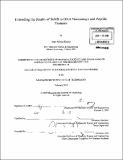Extending the realm of SuNS to DNA nanoarrays and peptide features
Author(s)
Akbulut Halatci, Özge
DownloadFull printable version (17.68Mb)
Alternative title
Extending the realm of Supramolecular Nanostamping to deoxyribonucleic acid nanoarrays and peptide features
Other Contributors
Massachusetts Institute of Technology. Dept. of Materials Science and Engineering.
Advisor
Francesco Stellacci.
Terms of use
Metadata
Show full item recordAbstract
Intense research on DNA arrays has been fostered by their applications in the field of biomedicine. DNA microarrays are composed of several different DNA sequences to be analyzed in parallel allowing high throughput information. Current methods to fabricate these arrays are serial in nature resulting in high prices that prevent their extensive utilization. Supramolecular Nanostamping is devised to solve this problem by harnessing the reversible bond formation between complementary DNA strands. This contact based technique is proven to replicate DNA arrays in a three step cycle: 1) Hybridization, 2) Contact and 3) Dehybridization. The overall goal of this thesis is to demonstrate the application of SuNS to DNA nanoarrays, i.e. increase the resolution of the current method, and broaden the printing capability to peptide arrays. The amount of analyte needed in an array scales with the feature size and spacing i.e. the total array size. The features of a DNA microarray are usually tens of micrometers in size with a spacing on the order of hundred micrometers. Therefore, miniaturization of such arrays is necessary for applications when analyte scarcity is an issue. DNA nanoarrays are promising lower analyte volumes due to their decreased feature size and spacing; namely high resolution. Unfortunately, DNA nanoarrays can only be fabricated by scanning probe microscopy based serial methods which generate each spot individually. To demonstrate SuNS is capable of dealing with the increasing demand to miniaturize DNA arrays, DNA features composed of a few DNA strands is replicated. The faithful printing of feature sizes as small as 14 nm with 70 nm spacing was shown. Apart from the capability to cope with features of various sizes, the strength of a printing method emerges from its ability to deal with different types of biomolecules. Coiled-coil peptides are treated analogously to complementary DNA strands due to the molecular recognition between two complementary peptide strands. Through Liquid Supramolecular Nanostamping (LiSuNS), the replication of coiled-coil motif peptides was demonstrated. To prove the multiplexing capability of the process, a master made of peptide and DNA features was successfully stamped via LiSuNS as well.
Description
Thesis (Ph. D.)--Massachusetts Institute of Technology, Dept. of Materials Science and Engineering, February 2010. Includes bibliographical references.
Date issued
2010Department
Massachusetts Institute of Technology. Department of Materials Science and EngineeringPublisher
Massachusetts Institute of Technology
Keywords
Materials Science and Engineering.